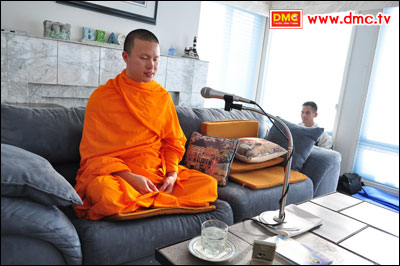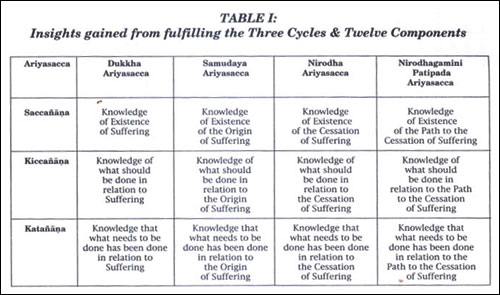Meditation
Meditation for Beginners
Overview #2
the Higher Training of the Mind
3. The Middle Way
The Middle Way [majjhima patipada] is a path of practice that avoids the extremes of either sensual indulgence tice that avoids the extremes of either sensual indulgence or self –mortification. It is a path of practice that is conducive to taming the mind, supreme knowledge, virtuous knowledge, the extinguishing of craving and for liberation from defilements. It is the practice of the Noble Ones, fitting for monks who have gone to the trouble to raise themselves from the status of householders. Monks should practice the Middle Way according to the Noble Eightfold Path [atthangikamagga], namely:
1. Right View [Samama Ditthi]
2. Right Intention [Samma Sankappa]
3. Right Speech [Samma Vaca]
4. Right Action [Samma Kammanta]
5. Right Livelihood [Samma Ajiva]
6. Right Effort [Samma Vayama]
7. Right Mindfulness [Sammma Sati]
8. Right Concentration [Samma Samadhi]
Sometimes the Noble Eightfold Path is summarized in three components, i.e. the Higher Training in Self-Discipline [adhisilasikkha]; the Higher Training of the Mind [adhicittasikkha]; and the Higher Training in Wisdom Prince Siddhattha became enlightened as the Lord Buddha, and gained insight into the Four Noble Truths which comprise:
1. The Noble Truth of Suffering [dukkha ariyasacca];
2. The Noble Truth of the Causation of Suffering [dukkhasamudaya ariyasacca];
3. The Noble Truth of the Cessation of Suffering [Dukkhanirodha ariyasacca];
4. The Noble Truth of the Path to the Cessation of Suffering [dukkhanirodhagamini ariyasacca].
Apart from allowing Prince Siddhattha to attain an end of defilements and become the Buddha, the Middle Way also allowed him to attain Nirvana while still alive [saupadisesanibbana] – eradicating all defilements from his mind even before the break up of his own psychophysical constituents or aggregates [khandha]. It also prepared him for the day of his death when he would pass away into permanent Nirvana [anupadisesanibbana] – at the break up of his aggregates and only his body of enlightenment [dhammakaya] remained, the latter would take its place permanently in the sphere of Nirvana [ayatananibbana].
It is for all these reasons that the Lord Buddha dared to compare the Supreme Dhamma of the Noble Eightfold Path to a precious jewel-because it has the potential to lead whoever practices it to the attainment of Nirvana. These conclusions came from the supreme wisdom of the Lord Buddha.
The insight gained by the Lord Buddha into the Four Noble Truths
Seeing & knowing: Three Cycles & Twelve Components
The insight gained by the Lord Buddha into the Four Noble Truths, was gained in three successive cycles of examination. Only then did he dare to announce that he had attained Enlightenment. Thus, three cycles of examination of four Noble Truths gives us a total of twelve components in his examination:
1. Saccanana: This first cycle of examination of the knowledge of the Four Noble Truths established the knowledge of the Truth of their Existence. Thus he was to find out: ‘this is the Noble Truth of Suffering’; ‘this is the Noble Truth of the Origin of Suffering’; this is the Noble Truth of the Cessation of suffering’; ‘this is the Noble Truth of the Way to the Cessation of Suffering’.
2. Kiccanana: This second cycle of the examination of the knowledge of the Four Noble Truths established the knowledge of one’s duty in relation to them. Thus he was able to find out: ‘this is what should be done in relation to the Noble Truth of Suffering’; ‘this is what should be done in relation to the Noble Truth of the Origin of Suffering’; ‘this is what should be done in relation to the Cessation of Suffering’; this si what should be done in relation to the Noble Truth of the Way to the Cessation of Suffering’;
3.Katanana: This third cycle of the examination of the knowledge of the Four Noble Truths established the knowledge of the fulfillment of one’s duty in relation to them. Thus he was able to find out; ‘what needs to be done has been done in relation to the Noble Truth of Suffering’; ‘what needs to be done has been done in relation to the Noble Truth of the Origin of Suffering’; ‘what needs to be done has been done in relation to the Cessation of Suffering’; ‘ what needs to be done has been done in relation to the Noble Truth of the Way to the Cessation of Suffering’.
The stages of the knowledge accrued during the twelve stages of the cycle of examination in three cycles can be shown in table form as shown in Table I.
The attainment of all twelve of the stages of the cycle of examination , are what made the Buddha dare to testify to his Enlightenment for the benefit of the ‘Group of Five’ – Enlightenment that is supreme in the human world, angel world, Mara-world, Brahma-world, animal-world, world of monks, world of Brahmins, world of angels or men-Enlightenment from which there will be no relapse into defilements and no further rebirth.
Frist Disciple: the most seasoned in the Perfections
At the end of the lord Buddha’s sermon, Kondanna, the leader of the ‘Group of Five’, became a Stream-Enterer [sotapana]. He had seen with the eye of (the body of) enlightenment that ‘Whatever is of the nature of arising, has the nature of cessation’ and in his context, he saw that his own aggregates were of such a nature-all of the nature of arising and cessation.
The earth – sprites [bhumadevata] unanimously praised the supremacy of the Dhammacakkapavattana Sutta, saying that it was incomparable with anything taught by monks, Brahmins, angels, Maras, gods or anyone in the world. The praises resounded amongst the angels sequentially higher and higher in the various levels of heaven until it reached the Brahma-world. The cosmos quaked and there arose limitless brightness.
The Buddha knew of the attainment of Kondanna and exclaimed ‘Annasi vata bho Kondanno, annasi vata bho kondanna’ (‘Kondanna now you know’) and for this reason Kondanna was henceforth known as ‘Annakondanna’ (Kondanna who knows).
In fact, the ‘group of five’ had already been ordained for a long time, and were already endowed with self-discipline and meditation. However, they still lacked the wisdom to see the path out of suffering. After the Buddha had clarified the harmfulness of the extremes of sensual indulgence and self-mortification, and advocated the following of the Middle Way or Noble Eightfold Path, the ‘group of five’, especially kondanna who was most seasoned in his Perfections was able to become a Stream-Enterer-the first to attain Enlightenment under the dispensation of our Lord Buddha.
Meditation - Related Articles
" />
" />
" />
" />








